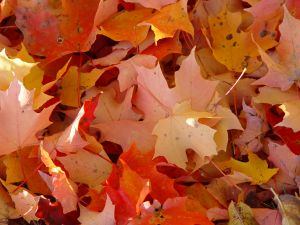Why is that? if your home is decorated in browns, beiges and other muted earth tones, you'll find that these deeply muted earthy tones simply clash with bright colors. I'll explain this below.
Complex vs. pure - Earth tones contain a predominant bright color PLUS a little of the complementary color in them, which is what "mutes" or takes the edge off the brightness of the predominant hue. For example, a muted red has some green in it, or a burnt orange has a bit of blue in it. This is why earth tones are considered "complex" colors. It simply means they contain more than one hue in them, and that is exactly why earth tones easily blend with each other like in this picture below.
 |
Bright colors, on the other hand are more "pure" which mean they contain mostly one hue (yellow, blue, red, orange, blue green etc.) plus some white and maybe a tiny bit of the complementary color just to take off that edge a little.
That is why bright colors appear "cleaner" then earth tone colors, and that's exactly why if you try to bring in a bright colored pillow or rug into a room full of earth tone colors (like the one above) it will make everything else around it look "dirty".
 |
| bright colors are more pure and work best with white and grays (design - Lindsey Harper) |
So what if your current decor is predominantly earth toned but you'd love to bring in some more color? here's my advice:
1. Brighten up the room with spice or jewel tones - not all earth tones are born equal. Some are brighter than others. Nature, of course is a full of great examples. Look at the picture below: the yellow and purple leaves are much brighter then the other leaves, yet they still blend well with the more muted hues of the other leaves.
You can apply this to your decor.
Spice colors (burnt range, reds, mustard yellows) are richer and brighter then the more muted earth tones (browns, amber, beiges), but still blend well with each other
Jewel tones can also blend well with earth tones.
1. Brighten up the room with spice or jewel tones - not all earth tones are born equal. Some are brighter than others. Nature, of course is a full of great examples. Look at the picture below: the yellow and purple leaves are much brighter then the other leaves, yet they still blend well with the more muted hues of the other leaves.
You can apply this to your decor.
 |
| bright and dull earth tones can live together happily |
Spice colors (burnt range, reds, mustard yellows) are richer and brighter then the more muted earth tones (browns, amber, beiges), but still blend well with each other
| spice colors |
 |
| earth tones jazzed up with orange spice tones |
The color palette above is an excellent example of a combination of muted earth tones and brighter spicy orange. Nature, of course is full of examples, like in the foliage leaves photo I found
 |
| foliage color range brightness - from dull to bright |
Jewel tones can also blend well with earth tones.
2. Going lighter and brighter on the walls - for an updated sharper look, try repainting your beige walls with a warm off white or cream. This will brighten up the space and create a bolder, more contemporary look. Yet, this "trick" will only work if you have lots of natural or warm artificial light in the room.White or off whites will look sad and dingy in a dark room.
 |
| rich and bright spice colors with a warm off white backdrop |
Bottom line - if you fell in love with the current trend of bright colors, but own a home full of earth tones, you can still brighten up the space by adding the brighter "cousins" of earth tones such as spice or jewel tones.
feel free to leave any comments below,
houzz
 |
| blog home |






No comments:
Post a Comment